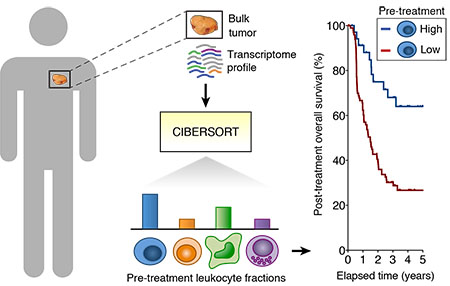


Posted June 3, 2015
Aaron Newman, Ph.D., Stanford School of Medicine
 Dr. Aaron M. Newman received a Peer Reviewed Cancer Research Program (PRCRP) Visionary Postdoctoral Fellowship Award in Fiscal Year 2011. Under the mentorship of Dr. Ash Alizadeh, Dr. Newman, of Stanford School of Medicine, proposed developing a robust model capable of predicting which patients (e.g., in a clinical trial) would most strongly respond to anti-cancer therapies. The foundation of this work was featured in a PRCRP highlight, Understanding and Predicting Patients' Response to Anti-cancer Therapies, in September 2013. Dr. Newman further developed this model during the second year of his award and recently published an article in Nature Methods that describes CIBERSORT-a computational method to determine the cellular composition of complex tissues using the gene expression profile (GEP) of a sample.1
Dr. Aaron M. Newman received a Peer Reviewed Cancer Research Program (PRCRP) Visionary Postdoctoral Fellowship Award in Fiscal Year 2011. Under the mentorship of Dr. Ash Alizadeh, Dr. Newman, of Stanford School of Medicine, proposed developing a robust model capable of predicting which patients (e.g., in a clinical trial) would most strongly respond to anti-cancer therapies. The foundation of this work was featured in a PRCRP highlight, Understanding and Predicting Patients' Response to Anti-cancer Therapies, in September 2013. Dr. Newman further developed this model during the second year of his award and recently published an article in Nature Methods that describes CIBERSORT-a computational method to determine the cellular composition of complex tissues using the gene expression profile (GEP) of a sample.1
Dr. Newman used samples from patients in a completed clinical trial that compared a personalized vaccine for Follicular Lymphoma (FL) to a non-specific vaccine to build and refine CIBERSORT. As with many types of cancers, patients with FL display varied rates of disease progression and diverse responses to treatment. Tumors are composed of numerous types of cells, and each tumor can have different types of mutations. These characteristics combine to influence, at least in part, a patient's response to FL therapies. Certain cell-identifying techniques, such as immunohistochemistry (antibodies used to identify cellular features in samples that have been affixed to a solid surface) and flow cytometry (cells suspended in a liquid solution flow past a detector and are sorted based on physical and/or chemical characteristics), are limited in their ability to sort cellular mixtures because they can only utilize a limited number of observable markers. Furthermore, sample preparation can lead to a loss of cells, which can alter the results. There are computational methods, other than CIBERSORT, that can use GEPs to sort complex samples into their individual cellular components. However, these methods are best used for well-characterized tissues and are less reliable for samples of unknown composition like solid tumors. CIBERSORT overcomes these limitations and accurately catalogues cell mixtures of unknown content.
The Nature Methods article presents the rigorous validation of CIBERSORT. A gene signature matrix (LM22), consisting of 547 genes that distinguish 22 different human immune cell subsets, was constructed as a benchmark for CIBERSORT to sort and enumerate white blood cell (i.e., leukocyte) mixtures. CIBERSORT's performance was then compared to six other computational methods using simulated data sets. The authors simulated numerous "tumors" that contained anywhere from 1% to 100% leukocyte content, which provided a reasonable approximation of biological environments. When simulated tumors contained less than 50% leukocyte content, other computational methods lost much of their accuracy. However, CIBERSORT detected different leukocyte types down to fractions as low as 0.5% of the total cell population, and it could even resolve closely relate cell types. Thus, CIBERSORT provides a considerable advantage over the other methods.
Although simulations provide valuable information, even the best simulations cannot fully capture a biological system. CIBERSORT was used to analyze both fresh and preserved samples. For all samples, CIBERSORT again outperformed the other computational methods. Finally, cell counts returned by CIBERSORT were compared to those collected using flow cytometry, and 90% of the results obtained using CIBERSORT significantly correlated with the flow cytometry data. As a comparison, analysis with the other computational methods did not return correlations that were statistically significant in more than 50% of the analyzed cell types.
CIBERSORT, combined with the LM22 matrix, provides a useful tool to catalogue complex cell mixtures in a highly sensitive and specific manner. Furthermore, this tool can be used on fresh, fixed, or frozen samples, hence complementing techniques that require live cells, like flow cytometry. With the publication of the Nature Methods article, CIBERSORT is now available on a public webserver (http://cibersort.stanford.edu), implemented by Dr. Chih Long Liu. Registered users of the website will have access to CIBERSORT for large-scale analysis of GEPs to define sample leukocyte profiles. Newman hopes that, among other uses, CIBERSORT can be employed to easily screen clinical trial participants to predict those who will respond to different treatments.

Publication:
1. Newman AM, Liu CL, Green MR, et al. 2015. Robust enumeration of cell subsets from tissue expression profiles. Nat Methods 12(5):453-457.
Link:














